I have an ADC sampling a downconverted RF signal at fs. I obtain N=2^15 samples of the RF input signal "fcarrier + fs/10".
The more I average, the more the entire noise floor shifts down (as expected, 10dB/dec) but also the phase noise skirt. I can average down to 100dB SNR (I didn't wait longer). For 1000 averages, the (zoomed) spectrum looks like this:
The phase noise skirt just moved down by 30dB as compared to the non-averaged version. This suggests I can average the phase noise out. But I would not expect it to be averaged out. According to http://www.bitsofbits.com/2015/07/07/signal-jitter-and-averaging/, the signal should be a cosine convolved with an exponential ("signal-leakage like") after infinite averages.
- Can phase noise be reduced?
- If yes, does can it be averaged out same as white noise? (This is what I observe above).
- How does this fit into the link posted above?
- Does it depend on the input signal? (sinusoid vs wideband)?

